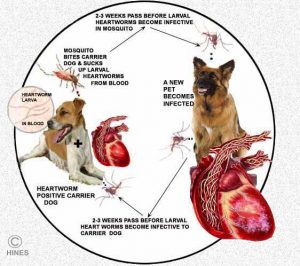What To Do When Your Dog Has Heartworms
Ron Hines DVM PhD
 Read About Heartworms: diagnosis, treatment & prevention here
Read About Heartworms: diagnosis, treatment & prevention here
 For some non-heartworm causes of coughing in dogs, go here
For some non-heartworm causes of coughing in dogs, go here
The scientific name of a dog heartworm is Dirofilaria immitis. These parasites are now common in pet and stray dogs in all states in American – except Alaska. In
In Alaska, heartworm positive dogs usually arrived from warmer climates with these parasites already present. They, or their cousins, Dirofilaria repens, are found Worldwide wherever mosquitoes are common. The warmer the climate and the more mosquitoes present, the more likely it is that your pet will be exposed to them.
Some Facts About Heartworms
Male heartworms are a few inches long. They look a bit like angel hair spaghetti. The female worms are much larger than the males. It is the females that cause most of the damage. Heartworms are transferred from dog to dog through the bite of an infected mosquito. In areas where heartworms are common, a few summers of repeated mosquito bites to dogs not receiving monthly preventative medications often results in an enormous number of adult worms in your pet’s heart. If not too offensive for you to look at, you can view one of those infected hearts here.
After a mosquito sucks larval heartworms up along with the blood from an infected dog; it rests for a period of time before these larva become infective. When that mosquito then bites another dog or the same dog, it transfers these microscopic larva as it bites. That is the only way a pet gets a new heartworm. The larva in an infected dog cannot mature or inhabit a dog’s heart unless they first pass through a mosquito. During the next 6–7 months, these transmitted larval heartworms migrate slowly through the dog’s body and eventually arrive at its heart. There they mature into adult worms.
Heartworm disease is worst in warm, damp areas of the World, where mosquitoes are active all year long. The more mosquito bites your pet gets, the more the chance it will become infected. So dogs that spend a lot of time out of doors or in unscreened areas are much more likely to contract heartworms than indoor pooches.
What Signs Might I See If My Dog Has Heartworms?
Very few dogs show any signs of ill health early in infection. That is why this disease is so dangerous. The first sign of heartworm disease I often notice is premature aging. Dogs with heartworms frequently gray prematurely around their muzzle and forelegs. Their coat looses its luster and, with time, their activity level decreases. Owners often don’t notice that because it occurs so gradually, and many write it off as “my dog is just getting old”. These dogs just don’t have their old energy, the “bounce in their step”. Of course, this occurs much slower or not at all when a dog only has a few mature heartworms or when their infection is primarily with the smaller male worms.
With time, a persistent, dry or hacking cough develops when many adult worms are present. This cough is most noticeable at night when your house is quiet and the dog is resting or in a sitting position. The cough is due to three things: bronchitis that develops as pieces of dying worms become trapped in the small blood vessels of the animal’s lungs, fluid that accumulates in the lungs as their heart fails and the enlarged damaged heart pressing on the pet’s wind pipe (trachea).
Later, the dog’s tummy assumes a pear-shaped, pot-bellied look as the pet’s liver enlarges and the fluid of sluggish blood circulation (ascites) accumulates in its abdomen. While these events are occurring, the dog’s heart and pulmonary arteries are gradually enlarging due to obstruction of blood flow the worm’s presence produce and damage to the heart’s major valves. Not only do mature heartworms clog up these arteries leading throughout the lungs; as the heartworms grow, they irritate the lining of this network of blood vessels. This irritation partially blocks these arteries and makes the heart work ever harder to pump blood through the lungs to receive oxygen. (pulmonary circulation) The more heartworms that are present, the harder the work becomes. Eventually, the pet’s heart begins to enlarge and fail due to overwork.
How Can I Keep My Dog From Getting Heartworms?
Ordinary “worm medicines” do not kill or prevent heartworms. To prevent your pet from catching heartworms, you must give it a special preventive medication once a month. Some that are in common used are Ivermectin (Heartgard®), Milbemycin oxime (Interceptor®), and selamectin (Revolution®) and imidacloprid-moxidectin (Advantage Multi® aka Advocate Spot On®). Some of these products are off-patent and available in generic form, others come and go. (Do not rely on that the product label instruction images in my article to still be correct. Carefully read the one that came with the product you personally bought)
All four of these medicines kill heartworms between the time that they enter your pet through a mosquito bite and the time they enter the heart. But they will not efficiently or rapidly kill heartworms at these doses and intervals after the worms take up residence in your pet’s heart.
What About Natural and Homeopathic Remedies And Preventatives That I Read About On The Internet?
Clients have written to me asking if they should trust their pet’s health to herbs and herbal combinations peddled over the internet. Things that contain stuff like geranium extracts, garlic, black walnut, artemisia, wormwood, clove buds, ginger root, etc. etc. Please do not do that. At best, your pet will be unprotected against heartworms. At worst, some of these extracts will damage your pet’s health. Both artemisia and black walnut shells can be toxic. Administration of a single dose of 1.75 mg/pound of juglone, the active ingredient in black walnut shells can kill a mouse, as can 22.5 mg/pound of alpha-thujone, the active ingredient in wormwood/artemisia. Use black walnut extracts to dye your hair or stain your furniture, thujone-free wormwood to flavor your vermouth and spices to flavor your food – not to prevent heartworms in the pets you love.
How Will My Veterinarian Check If My Pet Has Heartworms?
If you are lucky, your veterinarian checked your pet’s blood for heartworms before its heart was damaged. Many veterinarians check their patient’s blood for heartworms every year. The most accurate test checks for products that heartworms release into your pet’s blood stream. This is called an ELISA heart worm antigen test and the most commonly used one is the Idexx SNAP test that your veterinarian performs while you wait. A simpler, older, less accurate test the regular or modified Knott’s test, examines your pet’s blood for heartworm larva. If they are there, your dog has at least 1 mature male and one female heartworm. But if no larva (microfilaria) are there, your dog could still have adult heartworms (ones too young to pass larva, single-sex infections or parasites inhibited from reproduction [=occult infections]) – so dogs that are negative on the Knott’s test still need to have the ELISA test run. The only advantage of the Knott’s technique is that it is rapid and inexpensive, and (only when positive) sufficient to make a heartworm diagnosis. The Knott’s test will never tell you if your pet is free of heartworms.
As I mentioned, all heartworm in-office test kits rely on finding substances that only mature female heartworms produce. Since it takes 5-7 months from the day your pet was bitten by an infected mosquito for these substances to appear, there is no point in asking for these tests if your pet is less than 5–7 months old or if a possible exposure was less than 5–7 months ago. So if you missed giving heartworm preventative to your dog because of some family turmoil, the same 5–7 months have to pass before the tests have any value. Fortunately, many of the monthly heartworm prevention products will “reach back” a month or so, destroying baby heartworms on their way to the heart – even if you missed giving your pet its monthly pill.
Occasionally, the results of another blood test, a radiograph (x-ray) or an ultrasound examination will make your veterinarian suspicious of heartworms. When the vet sees a particular pattern of blood vessels in the pet’s lungs, combined with enlargement of the right side of the heart, heartworm disease often comes to mind.
If your veterinarian does an echocardiographic examination of your pet’s heart, the actual adult heartworms can sometimes be seen.
How Can I Get Rid Of Heartworms Once My Dog Has Them?
I begin pets on ivermectin and doxycycline as soon as heartworms are diagnosed. Heartworm larva (microfilaria) positive dogs need to be closely monitored by your veterinarian when first given ivermectin or any drugs in its class. That is because some dogs have reactions to the dying heartworm larva. Neither these drugs nor doxycycline will immediately cure your pet of the dangerous adult heartworms that are obstructing its heart circulation and damaging its lungs. But I believe that they will weaken these parasites and make them more susceptible to drugs that will kill them.
Unfortunately, there is only one FDA-approved drug available that will do that. It is called melarsomine. It is marketed by Boehringer Ingelheim as Immiticide®and by Zoetis as Diroban®. It contains arsenic. So, unfortunately, it can result in numerous side effects and even an occasional death in cases of advanced heartworm disease. It also does not repair whatever damage to your pet’s heart that has already occurred.
Before your veterinarian decides to give this medication, he/she will want to know if your pet is strong enough to survive the treatment. So, the vet will run blood tests to see if your pet’s liver and kidneys are still functioning normally. They will also x-ray its chest to see how much heart damage has occurred. Pets with heartworms are often anemic as well. Based on the test results, your veterinarian may decide it is safer to try to stabilize the pet by addressing some of these side issues before treating the heartworms.
Three Immiticide injections are usually given. Like a boxer in the ring, the first single injection is an attempt to “soften up” the parasites and kill as many as possible, and see how the dog handles the drug. Immiticide is very irritating, so the needle is inserted deep into the muscles of your pet’s back. After the injection, some of the heartworms will die and begin breaking apart. The danger now is that there is nowhere for these dying parasites to go, other than downstream into the lungs. Your pet might also be quite sore and stiff for a few days due to the painful injection. Try not to touch the sensitive injection area because it hurts; and the pet might even bite you. You will be asked to maintain your pet in strict “bed rest” for a period of time after these injections. That means outside on a leash to do its potty, no Frisbees etc. and nothing to get it excited in the house.
God-willing, everything will go well, your dog will come back to the vet in one month for two additional Immiticide injections, given 24 hours apart. Strict rest is still very important after the second and third injections. Veterinarians are individuals, their procedure may differ from what I described based on their experience and training. Follow their instructions, not mine.
After receiving Immiticide® or Diroban®, watch your pet very carefully. It is common for these dogs to run a fever, to eat less and to drink more. It is also common for them to cough and to be depressed. Sometimes they will have nose bleeds as well. If any of these things occur, call your veterinarian immediately. If anything more serious happens, such as weakness, difficult breathing, bloody cough or bluish gums, put your pet in the car or call a taxi and get it to the Doc immediately.
The first 7 -10 days after heartworm treatment are the most dangerous. But your pet is really not out of the woods for several weeks more. These side effects are happening because the dead worms are breaking up and being carried into the lungs where they cause a severe inflammation. With time, the pet’s body will absorb them. The danger is that a big wad of dead worms and clots will plug up a major artery in the lungs (an embolism). Major embolisms (emboli) can be fatal. The less active your pet is during this period, the less likely a fatal embolism is to occur. Some veterinarians still suggest small amounts of aspirin during this period. But its use has fallen out of favor with veterinarians who study the disease.
How Should I Care For My Dog After It Receives The Immiticide Injections?
The most critical time is the first few weeks after the Immiticide®/Diroban® injections. This is the time the dog’s body must deal with all the dead heartworms in its circulation. The most important thing during this period is to keep the dog as still as possible. This means as little exercise as possible. The best way to do this is to keep your pet in a cage (crate) in a cool, isolated, quiet area. Take the pet out on a leash frequently enough to relieve itself – but no more.
Because it is common for dogs to run a fever during this period. Keep the house cool and be sure it gets plenty of water.
How Risky Is This Treatment For My Dog?
Here are the factors that determine how risky heartworm treatment will be for your pet:
1) The length of time your pet has been infected
It takes approximately 7 months from the time a mosquito bites your pet until an adult heartworm develops that begins to damage your pet’s circulatory system. This damage occurs over an extended period of time, not right away. So young dogs (less than 2–3 years old) and recently infected dogs usually have considerably less circulatory damage – and less risk unless they have overwhelmingly high numbers of heartworms (caval syndrome).
2) The Amount of Heart, Liver and Kidney Damage That Has Already Occurred
The degree of elevation in certain blood tests will tell your veterinarian the extent of any damage to the pet’s liver and kidneys. An x-ray of your pet’s chest, or perhaps a cardiac ultrasound will show the degree of heart damage, if any. We always hope that no damage is found. Any significant damage increases the risks of Immiticide®/Diroban® treatment.
3) The Number of Heartworms Present
The damage done is proportional to the number of female worms present. Dogs with high heartworm numbers are at much greater risk. Other than with an overwhelming, sudden exposure to mosquitoes, the number of heartworms present in your pet likely to be most related to the number of months or years that the pet lived without monthly heartworm preventatives. Of course, dogs that live indoors in screened homes are at considerably lower risk of mosquito bites.
4) The Size Of Your Dog
The diameter of the pulmonary arteries is much larger in big dogs than in small dogs. So small dogs are at a greater risk than large dogs with the same number of heartworms. However, I see many more cases of heart worm disease in large breeds. But I associate that with their spending more time out-of-doors.
5) The Sex Of The Heartworms
It is the larger female worms that do most of the damage. In some infections, the worms are mostly the smaller males. I know of no chemical test that will tell what sex the worms are. However, a cardiac ultrasound can often see the heartworms and might tell if they are the larger females or smaller males.
Is There An Alternative Treatment For My Pet?
Continue on to this link to read about that: Heartworms, Diagnosis Treatment & Prevention
What Is Wolbachia?
Wolbachia is an organism that lives inside of heartworms. Many veterinarians now believe that Wolbachia is responsible for some of the blood clots and malaise that occur during treatment, and that it in some way protects the worms from the drugs we use to kill them. Because of this, more and more veterinarians are pre-treating dogs with doxycycline, to destroy Wolbachia prior to administering Immiticide® or Diroban®.
What Is Caval Syndrome?
If a pet is bitten by an unusually high number of infected mosquitoes in a single season, enough heartworms can develop to suddenly plug up the large vein that returns blood to the heart. This vein is called the vena cava. These dogs may suddenly collapse, and they frequently pass dark brown-colored urine. Most do not survive. A few can be saved by emergency surgery, during which a forceps is passed into the heart and vena cava and the worms manually extracted. Eighty to over one hundred worms can sometimes be found in the heart of a 40 pound (ca. 18 kg) dog with caval syndrome.
How Often Should My Dog Be Tested For Heartworms?
If you give your dog or cat a once-a-month heartworm preventative according to the instructions on the package, it should not get heartworms. You can read the controversy over that here.
So, why do veterinarians suggest annual heartworm tests? Here are several reasons why:
1) Your pet may have caught heartworms before you began giving the monthly preventative.
2) You may have accidentally missed some months.
3) Your pet may have spit out the medication.
4) Some State veterinary laws require a physical examination or heartworm test before a prescription for heartworm medication can be renewed.
What If My Dog Is Still Positive For Heartworms After Being Treated For The Adult Parasites?
Young, female heartworms are the hardest to kill with Immiticide. So, some might survive the treatment. If a follow-up blood antigen test is still positive 6 months after the dog was treated, some living worms did survive.
The health of these dogs is usually much improved because the majority of the heartworms are now gone. It is rarely if ever necessary to retreat these dogs that still have a few residual worms 6 months after “adultcide” treatment. Should you contemplate re-treatment, you have to understand that killing the very last worm will not improve the heart damage that has occurred (if any). I usually suggest that dog owners put those dogs on a monthly heartworm preventative (preferably one that contains moxidectin) along with a year of pulsed (intermittent) doxycycline administration.
You are on the Vetspace animal health website
Visiting the products that you see displayed on this website help pay the cost of keeping these articles on the Internet.


